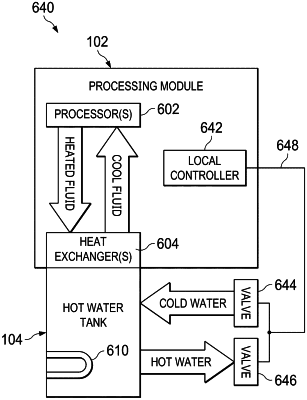| CPC H05K 7/20281 (2013.01) [F24D 17/0005 (2013.01); H05K 7/20236 (2013.01); H05K 7/2039 (2013.01)] | 17 Claims |

|
1. A method for managing a processing load of a processing module and thermal energy produced by the processing load, the method comprising;
identifying, by the processing module, a hot water profile, wherein the hot water profile includes information regarding usage of hot water from a hot water tank that serves as a sole heat sink for the thermal energy;
determining, by the processing module, that it is economically desirable to increase the processing load based on at least one of an economic value generated by the processing load, a cost of energy needed to support the processing load, and an economic value of the thermal energy transferred to the hot water tank based on the hot water profile;
determining, by the processing module, whether a temperature differential between the processing module and the hot water tank is large enough to ensure that the hot water tank is able to absorb thermal energy that will be produced by increasing the processing load without overheating the processing module;
increasing, by the processing module, the processing load in response to the economic desirability only if the temperature differential is large enough to prevent the processing module from overheating;
monitoring whether a current temperature of the hot water in the hot water tank is approaching a maximum temperature threshold that defines a safe temperature for end use of the hot water; and
dynamically modulating the processing load to prevent the current temperature from exceeding the maximum temperature threshold even if the temperature differential is sufficient to support increased processing.
|